The PNY CS1311 and CS2211 SSD Review: MLC vs TLC at 15nm
by Billy Tallis on April 15, 2016 8:00 AM ESTATTO
ATTO's Disk Benchmark is a quick and easy freeware tool to measure drive performance across various transfer sizes.
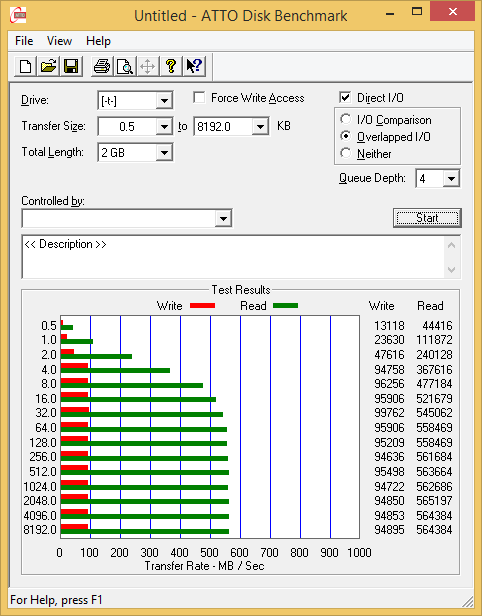 |
|||||||||
Aside from the 120GB drive's hobbled write speed, everything looks normal with the ATTO plots. The 120GB drive is just too small to deliver the full performance its controller is capable of, even though it's the smaller variant of the S10.
AS-SSD
AS-SSD is another quick and free benchmark tool. It uses incompressible data for all of its tests, making it an easy way to keep an eye on which drives are relying on transparent data compression. The short duration of the test makes it a decent indicator of peak drive performance.
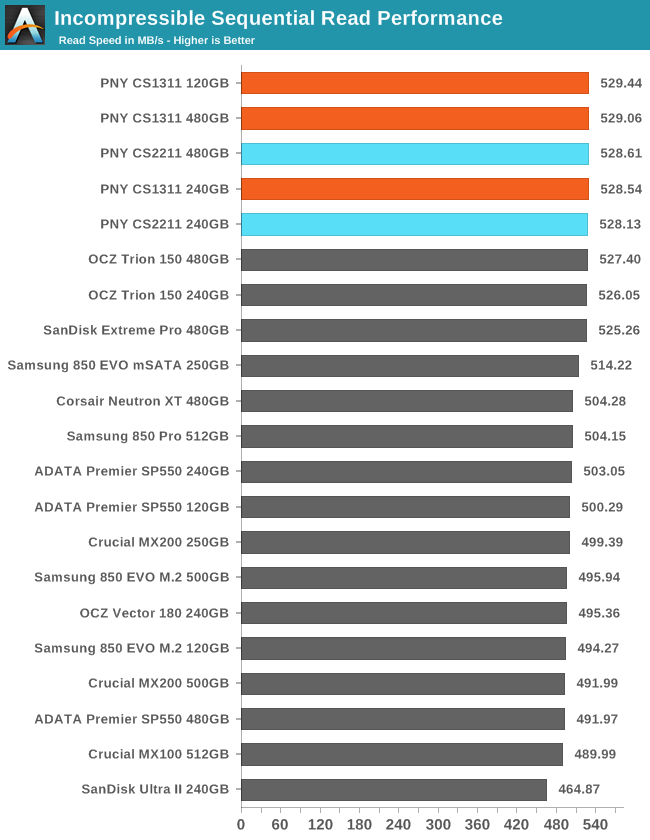
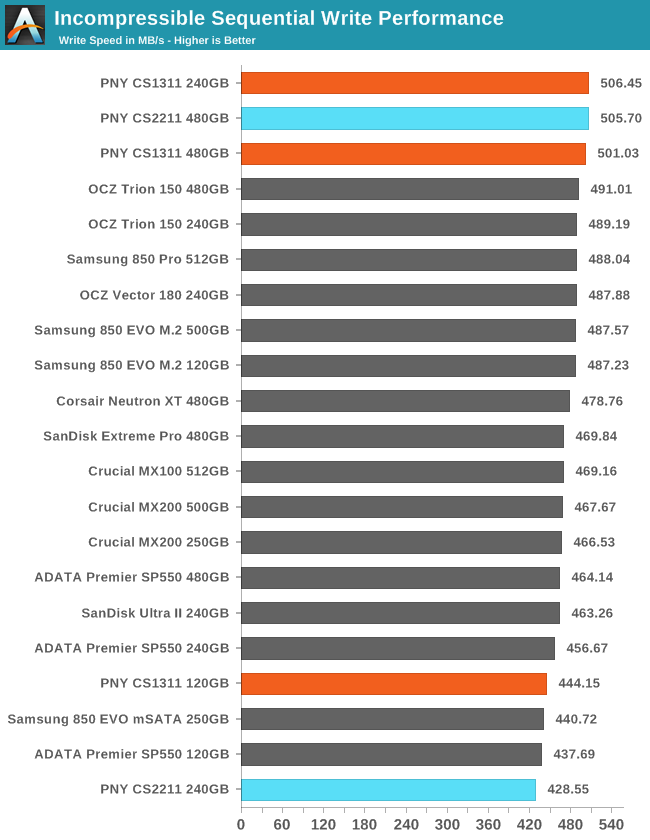
Peak sequential read speeds of the PNY drives are all top-notch, but the 240GB CS2211 is oddly slow on the write test.
Idle Power Consumption
Since the ATSB tests based on real-world usage cut idle times short to 25ms, their power consumption scores paint an inaccurate picture of the relative suitability of drives for mobile use. During real-world client use, a solid state drive will spend far more time idle than actively processing commands. Our testbed doesn't support the deepest DevSlp power saving mode that SATA drives can implement, but we can measure the power usage in the intermediate slumber state where both the host and device ends of the SATA link enter a low-power state and the drive is free to engage its internal power savings measures.
We also report the drive's idle power consumption while the SATA link is active and not in any power saving state. Drives are required to be able to wake from the slumber state in under 10 milliseconds, but that still leaves plenty of room for them to add latency to a burst of I/O. Because of this, many desktops default to either not using SATA Aggressive Link Power Management (ALPM) at all or to only enable it partially without making use of the device-initiated power management (DIPM) capability. Additionally, SATA Hot-Swap is incompatible with the use of DIPM, so our SSD testbed usually has DIPM turned off during performance testing.
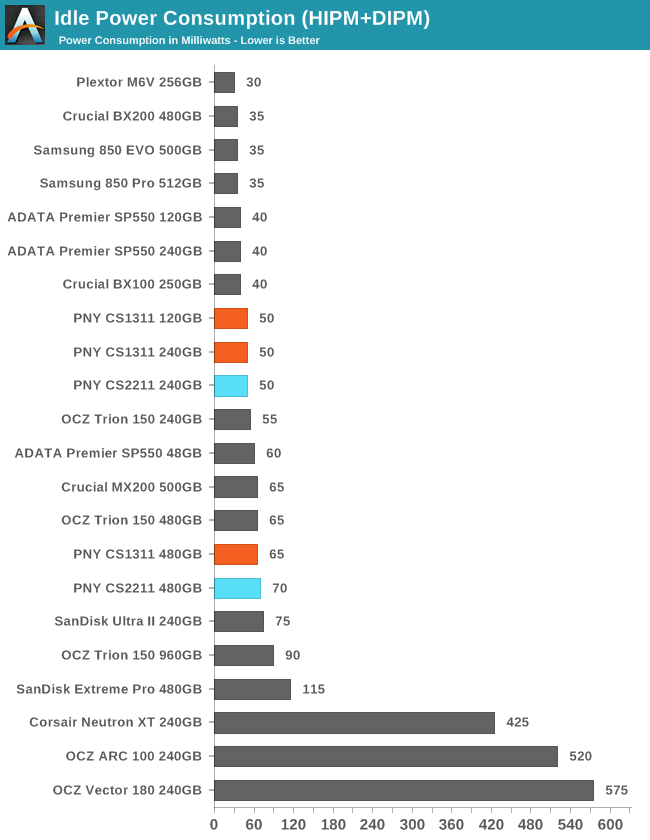
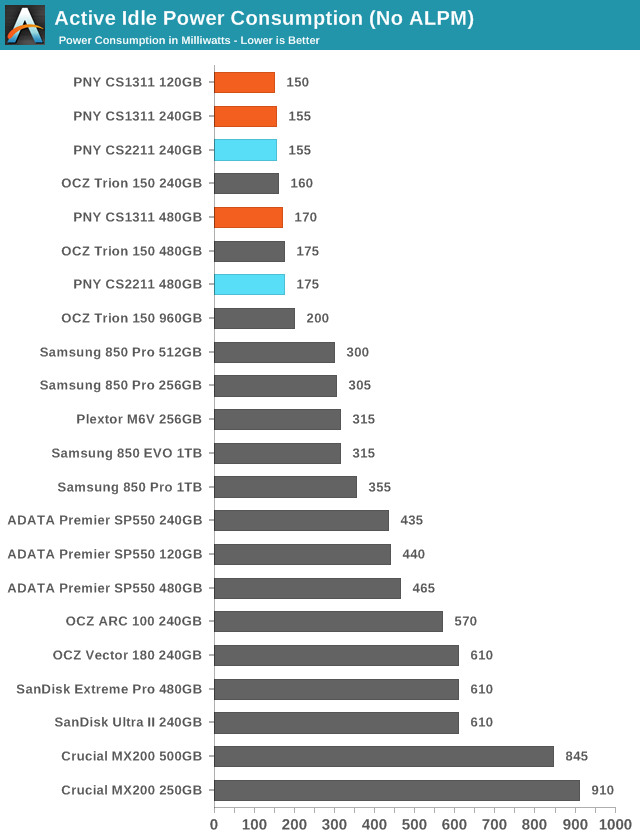
The S10C controller does seem to save a bit of power over the larger S10-X, with and without ALPM. The S10C sets a new record for the best idle power without ALPM.










43 Comments
View All Comments
alexdi - Friday, April 15, 2016 - link
I read this with only one question in mind: does it beat the 850 Evo? Save for a few ticks in power usage, apparently not. The Evo is perpetually on sale. I've yet to see a compelling reason to opt for anything else on a desktop.ingwe - Friday, April 15, 2016 - link
Completely agree. I am not tied to it, but I don't see any reason to recommend pretty much anything else.fierywater - Friday, April 15, 2016 - link
The CS1311 gets marked down from time to time; I picked up my 480GB one for $100 while the Evo 850 500GB usually doesn't get marked down below $130 (and it was $150 everywhere when I picked up the CS1311). It's plenty fast for real world use, especially as a drop-in replacement for an HDD. I think there's a place for drives like it, although that applies less to the CS2211.lilmoe - Friday, April 15, 2016 - link
For the performance and value you're getting with the EVO, $30 is well worth the extra, and hardly an amount worth saving going for the CS1311, or any other TLC drives at that. In the matter of fact, lots of the current consumer MLC drives don't compare to the value, performance, or in some cases, the endurance and features you're getting with the EVO.ATC9001 - Monday, April 18, 2016 - link
I agree from most "prosumers" which are frequent to read this article, but for the mainstream user, I don't think its worth it (spending the $30+). Any SSD is better than a HDD, but some garbage bargain bin SSDs aren't worth the cheap price (this being the first exception). I know most people (including myself) think the same thing alexdi posted when reading this....is this going to beat the evo? It doesn't, but at the same time it's not far off from it, and $30 bucks can cause it to break a price plane for some mid range users.Each person has there own utility curve or price performance idea, and for me, this is the first drive since the 840 EVO was released in which I would say it's not worth the x dollars to just get the evo!
Stuka87 - Friday, April 15, 2016 - link
Having a quality, reliable drive is not reason enough for you? If you want to buy a drive that has a much shorter life span, go for it. But Anybody that cares about data, is not going to by a TLC drive over a MLC drive.lilmoe - Friday, April 15, 2016 - link
FYI, TLC VNAND has better endurance than most 15nm MLC drives...Impulses - Friday, April 15, 2016 - link
Define much shorter...You're talking in broad strokes about a bunch of different things in the same breath. Life span and reliability aren't necessarily the same thing, unless you need drives to be reliable for 15yrs...
15yrs ago I was wondering if I'd ever fill my 75GB Deathstar, I'm not sure I'd even keep a drive 5+ years. My 2x 850 EVO have been nothing but reliable since I bought them last year.
DanoSpumoni - Friday, April 15, 2016 - link
Same here. the M.2 850 EVO 500GB is my go to SSD right now. They are in all my computers either in M.2 slots or M.2-> SATA sleds. The performance and reliability is hard to beat. I only buy M.2 SSDs now for future compatibility because they last so long I know they'll outlive the computers they inhabit right now. When the 1TB version drops to ~$150 I'll grab some more...Impulses - Friday, April 15, 2016 - link
I'm sitting on 2x 1TB, bought at like $310 & $330 IIRC, seen them for $260 lately... Waiting for the 2TB to drop lower and I might add one of those. :D